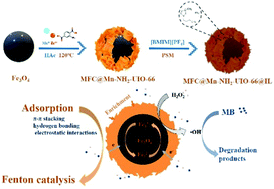Adsorption and Fenton catalysis technologies have been widely used to treat wastewater. Herein, Zr-MOF composites are synthesized with Mn-doped magnetic hierarchical porosity and ionic liquid (IL) post-functionalization (MFC@Mn-NH2-UiO-66@IL). The characterization of the composite shows that the MOF we synthesized is laminar and porous, which promotes the adsorption process and subsequent H2O2 decomposition catalysis. Electrostatic interactions, hydrogen bonds, and π–π stacking interactions between [BMIM][PF6] and methylene blue (MB) greatly improve the adsorption performance. Subsequently, H2O2 is rapidly decomposed in a Zr-MOF and Fe3O4 system to produce ˙OH for the oxidative decomposition of MB. Zr plays an electron transfer role in the catalytic reaction. The MFC@Mn-NH2-UiO-66@IL material has a high adsorption capacity for aqueous MB solutions. In combination with the subsequent Fenton-like oxidation reaction, a removal efficiency of 98% is achieved in 90 min. We believe that our work has essential impact in the field of wastewater treatment based on the advantages of the MOF's dual function in degrading pollutants in water.

